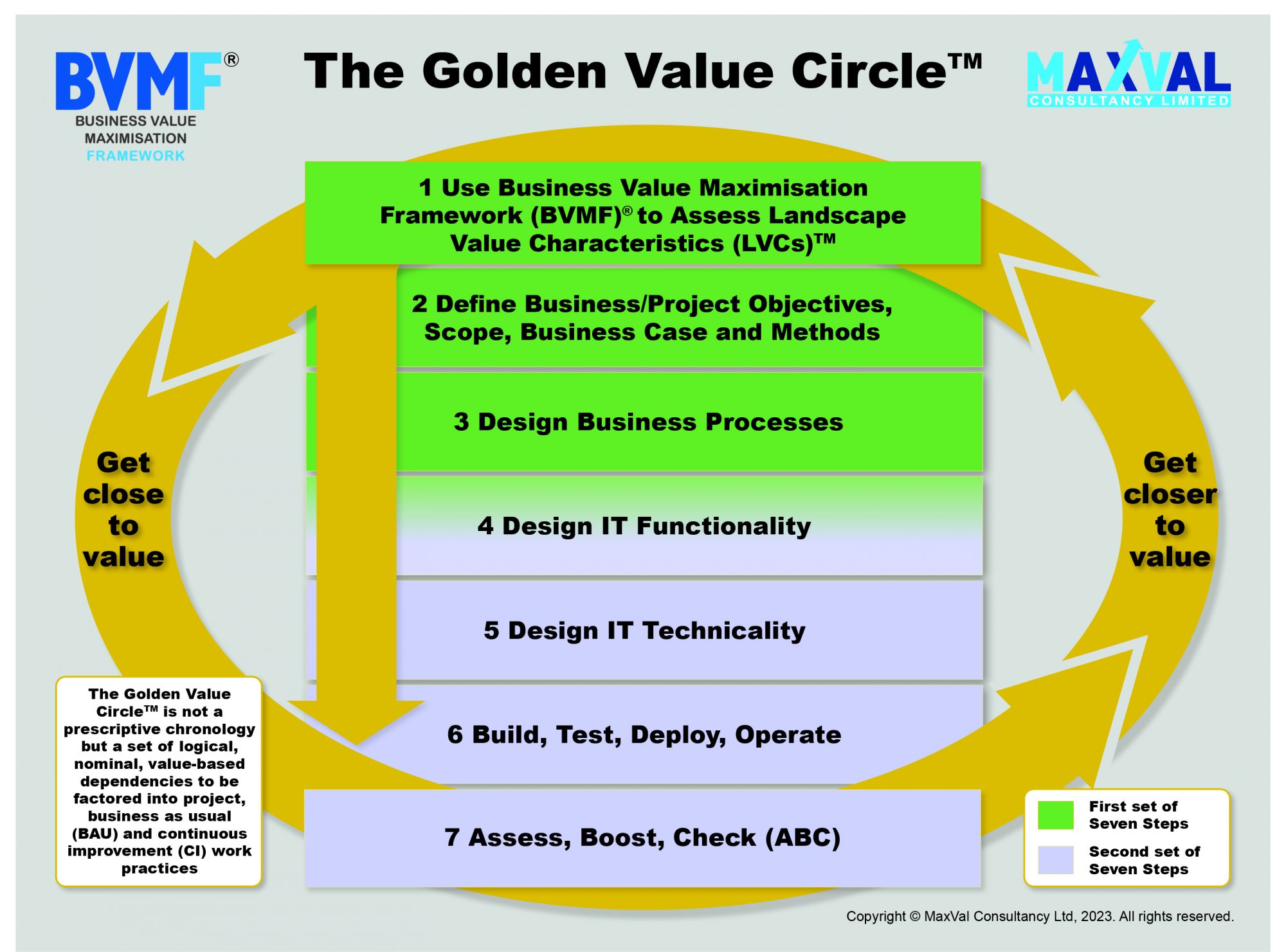In this part one of a two-part series, David Jacobs, director of MaxVal Consultancy’s Business Value Maximisation Research and Development Programme, proposes seven foundational principles to increase business value, success and return on investment from IT and digital transformation
I have previously stated that sky-high increases in value, success and ROI from IT and digital transformation are eminently possible, providing the fundamental principles of IT value maximisation (that have not, to date, been well defined or available in concise and usable form) are followed.
I have run a 30-year R&D programme to identify such principles, which now form the basis of Business Value Maximisation Framework (BVMF)®.
At MaxVal Consultancy, we use BVMF® to help organisations boost value, success and ROI to levels consistently higher than industry norms. BVMF® comprises nearly 100 models and 450 techniques and is being continually refined and expanded.
If you’d like to get more net benefit from the effort, time and money you are expending on IT, to get started, in this two-part series, I will cover seven basic principles.

Set up your golden value circle, ask the right questions
IT method selection should not come first! Each piece of work has unique characteristics that indicate a specific combination and flavour of approaches/methods will get the best result. A blanket aim to use a single method, say Agile, for all work is unlikely to be the most beneficial way forward. Yes, some value may arise but it will typically be average in magnitude, less predictable or consistent than when each piece of work is assessed individually.
To make such an assessment, look at the aspects of the intended work. We use BVMF®’s Landscape Value Characteristics (LVCs)™ and Step Diagram™ to do this and to focus on where the potential value is (Propensity). And by the way, always tailor methods to specific needs. Don’t be afraid to make up your own ways of working!
Do not make final decisions on your project, process or IT methods until after conducting this exercise as the nature of your objectives and characteristics of your organisation and its wider market will colour the best way to work.
Our LVCs help you to see the context of how your business organisation sits within its market or environment, to steer you towards an appropriate blend of methods. They also help you to know how best to use the methods.
The nature of your IT and business/project resources and the relationship between these two functions will also have a bearing. BVMF®’s Step Diagram™ helps you to evaluate method(s) from a time scale and level of ambition point of view. What sort of work practice and roll out schedule will most suit: granular and frequent or more purposeful and planned out?
Define objectives and project/work methods
You must know what you are trying to achieve, in business terms first, IT second; what your piece of work is aiming to achieve, at a high business level (mission, vision, etc.*) Cascade your objectives all the way down to the nuts and bolts of departmental goals/aims. Short and long-term aspects of the aims should also be considered. This means that any business processes included in the work’s scope will have a well-defined set of objectives to deliver against, value being achievement against objectives.
* Business analysts use VMOST, for example. Vision, Mission, Objectives, Strategy, Tactics. In BVMF®, we use a holistic end-to-end value-based model called Layers of Focus (LoF)™
Design business processes
Any business process involved must optimally address the objectives defined above. Much debate is had in industry over where in a piece of project work business processes are reviewed and reengineered. Well, if processes do not optimally address the objectives defined logically/dependently before any IT is designed, you are unlikely to end up with an optimised operation.
Bill Gates said a poor process computerised will become a worse process – I paraphrase, but heartily agree with Mr William Henry Gates III! Furthermore, there are respects in which IT can help processes to become genuinely better, but such uplifts cannot be exploited unless we start with optimal processes. Ask, in a magic, blue sky world, what would our processes be if no practical constraints were leaning on us?
Yes, you can allow incoming software to guide the improvement of business processes that make you unique in your industry/market (working in reverse) but do you want software providers defining your processes, not being certain that any IT you design, build and deploy will optimally support your critical unique selling points (USP)s?
Prepare to design IT functionality
In order for IT functionality to boost processes’ effectiveness in an optimal way, its design must be driven by optimal processes! When designing such processes, bear in mind that IT will allow a different, more centralised process to be created, so incoming IT functionality can further boost the quality, speed and accuracy of the process, providing guidelines are followed so that humans and IT do what they are respectively good at.
Stay close to value, from start to finish
To manifest maximum value, you must have ways to identify, track and optimise. We have identified the key ingredients of the value cake, developing models and techniques for identifying the propensity of each to contribute. We make sure each ingredient mixes most effectively with the other ingredients to produce a hugely improved cake!
The suggestion here is to focus on the key ingredients and monitor their contribution to value. We have developed Business Value Equation (BV EQ)™, which allows us to predict and monitor value and ensure all value ingredients are performing at peak levels.
Value realised will be as strong as the value chain’s weakest link, or the value cake’s weakest layer, which is why often the eventual value/success/ROI is manifestly less than expected. BVMF® helps to conceive, track and boost value all the way through so it doesn’t get dissipated from being impeded by practical constraints of IT technology, for example.
Conclusion
So, I suggest you:
- Don’t select your IT method before you assess the specific project/piece of work’s business landscape, timescales, environmental factors, characteristics, etc.
- Do design optimal business processes to address your stated objectives.
- Do design your IT functionality to support/boost optimally designed business processes.
- Do keep going once new processes and systems are live, continue assessing, boosting and checking value (our Crossword Diagram™ model can help) to address your stated objectives.
If you would like to delve deeper into the world of higher levels of value, success and ROI, please visit www.maximum-value.co.uk, where you can read about BVMF® and request a copy of our free IT Business Value Capability Assessment (ITBVCA)™. This will help you to see how well you are doing by scoring your project/work practices on 24 key criteria.
Contributor Details
More About Stakeholder
-
Business value maximisation for IT with MaxVal Consultancy
MaxVal Consultancy helps organisations raise levels of business value, success and return on investment (ROI) arising from organisational IT and digital transformation projects.
Editor's Recommended Articles
-
Must Read >> 7 Ways for a small business to boost their cash flow















